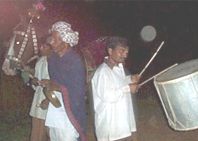 A Personal India
Every man has a view of his land and his people. This is mine. Of India -- D V Sridharan
A Personal India
Every man has a view of his land and his people. This is mine. Of India -- D V Sridharan
|
Chetak Country [contd] Sunny's son Kunal is a handsome young man. He banters a little. I hear Sunny's wife for the first time. The demure lady, her head covered with the end of her saree, is an elegant conversationalist! With a sense of humour too.
She is a persuasive hostess pressingher guests to help themselves to more food. Sunny,the silent Thakur, head of the family, glows in contentment. The place is somewhat dark but the effect is magical. A gathering in a corner of this land; of travelers from the south of India and Europe, in a place run by a Rajput and an Englishwoman, where traditions are sought to be conserved. Yet, winds of trade throttle in. India doesn't change - it evolves! |
'Progress' comes to my village ...what choices do I have? Muttukkadu is an ancient, insignificant village near Chennai, on the East Coast Road [ECR]. Its name translates roughly as 'End Woods'. This was for a good reason. Prior to 1970, when the current bridge over the creek at the Muttukkadu Boating Centre was built, Muttukkadu was land's end. It was also an important overnight stop for boats plying on the Buckingham Canal, which runs past the village. Villagers ran small eateries for boats' passengers and crew.They exported their produce—mostly, firewood and charcoal— to the city through these boats. There were far fewer shops than the hundreds that face the ECR today, and those, faced the gentle, slow-paced, canal. Muttukkadu is a village with four major hamlets. It has the notoriously named "Colony" where the Dalits now live. Many have turned Christian and in the 1980s a huge church came up here with money from abroad; Germany, they say.There is the "Kuppam", where fishermen plying catamarans have lived for centuries. There is the 'Yellow Board", proudly named after a sign that announced the new bridge in the 1970s. |
Here the few upper castes lived, many of them Telugu speaking. This is also the place where the huge influx of new arrivals from all over the state have made their homes. The most picturesque of the four hamlets was Jambodai, adjacent to the Kuppam and lying right by the sea. Till 1990, rice was cultivated in Jambodai, barely 100 yards from the sea. A little brook ran through the village round the year and ground water was at 3 feet! In all about twenty acres were cultivated by descendants of a Naicker and one Muslim family. The hamlet had been settled in favour of Naicker's family the 1770s by the French East India Company, following a coach accident in which he lost his life. [That is the folk memory; the event probably relates to the Dutch who had a garrison at the present Fisherman's Cove run by the Taj Group of hotels]. Jambodai was fringed by coconut trees and it was a fine copy of a classical Kerala village. It was very popular with film producers. Film crews parked their vans on the road and transported camera and equipment by bullock carts over the sand, to Jambodai, about half a kilometre away. There, they could recreate an idyllic village at no cost at all. [NEXT PAGE] |
|
A Personal India :: Index GoodNewsIndia :: Home Reader Services |
